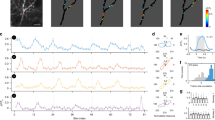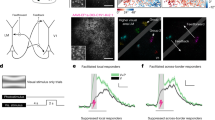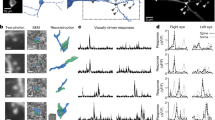Abstract
How a sensory stimulus is processed and perceived depends on the surrounding sensory scene. In the visual cortex, contextual signals can be conveyed by an extensive network of intra- and inter-areal excitatory connections that link neurons representing stimulus features separated in visual space1,2,3,4. However, the connectional logic of visual contextual inputs remains unknown; it is not clear what information individual neurons receive from different parts of the visual field, nor how this input relates to the visual features that a neuron encodes, defined by its spatial receptive field. Here we determine the organization of excitatory synaptic inputs responding to different locations in the visual scene by mapping spatial receptive fields in dendritic spines of mouse visual cortex neurons using two-photon calcium imaging. We find that neurons receive functionally diverse inputs from extended regions of visual space. Inputs representing similar visual features from the same location in visual space are more likely to cluster on neighbouring spines. Inputs from visual field regions beyond the receptive field of the postsynaptic neuron often synapse on higher-order dendritic branches. These putative long-range inputs are more frequent and more likely to share the preference for oriented edges with the postsynaptic neuron when the receptive field of the input is spatially displaced along the axis of the receptive field orientation of the postsynaptic neuron. Therefore, the connectivity between neurons with displaced receptive fields obeys a specific rule, whereby they connect preferentially when their receptive fields are co-oriented and co-axially aligned. This organization of synaptic connectivity is ideally suited for the amplification of elongated edges, which are enriched in the visual environment, and thus provides a potential substrate for contour integration and object grouping.
This is a preview of subscription content, access via your institution
Access options
Access Nature and 54 other Nature Portfolio journals
Get Nature+, our best-value online-access subscription
$29.99 / 30 days
cancel any time
Subscribe to this journal
Receive 51 print issues and online access
$199.00 per year
only $3.90 per issue
Buy this article
- Purchase on SpringerLink
- Instant access to full article PDF
Prices may be subject to local taxes which are calculated during checkout



Similar content being viewed by others
References
Rockland, K. S. & Lund, J. S. Intrinsic laminar lattice connections in primate visual cortex. J. Comp. Neurol. 216, 303–318 (1983)
Gilbert, C. D. & Wiesel, T. N. Columnar specificity of intrinsic horizontal and corticocortical connections in cat visual cortex. J. Neurosci. 9, 2432–2442 (1989)
Angelucci, A. & Bressloff, P. C. Contribution of feedforward, lateral and feedback connections to the classical receptive field center and extra-classical receptive field surround of primate V1 neurons. Prog. Brain Res. 154, 93–120 (2006)
Gilbert, C. D. & Li, W. Top-down influences on visual processing. Nat. Rev. Neurosci. 14, 350–363 (2013)
Yoshimura, Y., Dantzker, J. L. M. & Callaway, E. M. Excitatory cortical neurons form fine-scale functional networks. Nature 433, 868–873 (2005)
Morgenstern, N. A., Bourg, J. & Petreanu, L. Multilaminar networks of cortical neurons integrate common inputs from sensory thalamus. Nat. Neurosci. 19, 1034–1040 (2016)
Ko, H. et al. Functional specificity of local synaptic connections in neocortical networks. Nature 473, 87–91 (2011)
Cossell, L. et al. Functional organization of excitatory synaptic strength in primary visual cortex. Nature 518, 399–403 (2015)
Wertz, A. et al. Single-cell-initiated monosynaptic tracing reveals layer-specific cortical network modules. Science 349, 70–74 (2015)
Lee, W.-C. A. et al. Anatomy and function of an excitatory network in the visual cortex. Nature 532, 370–374 (2016)
Markov, N.T. et al. Weight consistency specifies regularities of macaque cortical networks. Cereb Cortex 21, 1254–1272 (2011)
Malach, R., Amir, Y., Harel, M. & Grinvald, A. Relationship between intrinsic connections and functional architecture revealed by optical imaging and in vivo targeted biocytin injections in primate striate cortex. Proc. Natl Acad. Sci. USA 90, 10469–10473 (1993)
Bosking, W. H., Zhang, Y., Schofield, B. & Fitzpatrick, D. Orientation selectivity and the arrangement of horizontal connections in tree shrew striate cortex. J. Neurosci. 17, 2112–2127 (1997)
Martin, K. A. C., Roth, S. & Rusch, E. S. Superficial layer pyramidal cells communicate heterogeneously between multiple functional domains of cat primary visual cortex. Nat. Commun. 5, 5252 (2014)
Sincich, L. C. & Blasdel, G. G. Oriented axon projections in primary visual cortex of the monkey. J. Neurosci. 21, 4416–4426 (2001)
Schmidt, K. E., Goebel, R., Löwel, S. & Singer, W. The perceptual grouping criterion of colinearity is reflected by anisotropies of connections in the primary visual cortex. Eur. J. Neurosci. 9, 1083–1089 (1997)
Kapadia, M. K., Ito, M., Gilbert, C. D. & Westheimer, G. Improvement in visual sensitivity by changes in local context: parallel studies in human observers and in V1 of alert monkeys. Neuron 15, 843–856 (1995)
Geisler, W. S., Perry, J. S., Super, B. J. & Gallogly, D. P. Edge co-occurrence in natural images predicts contour grouping performance. Vision Res. 41, 711–724 (2001)
Chen, X., Leischner, U., Rochefort, N. L., Nelken, I. & Konnerth, A. Functional mapping of single spines in cortical neurons in vivo. Nature 475, 501–505 (2011)
Chen, T.-W. et al. Ultrasensitive fluorescent proteins for imaging neuronal activity. Nature 499, 295–300 (2013)
Wilson, D. E., Whitney, D. E., Scholl, B. & Fitzpatrick, D. Orientation selectivity and the functional clustering of synaptic inputs in primary visual cortex. Nat. Neurosci. 19, 1003–1009 (2016)
Takahashi, N. et al. Locally synchronized synaptic inputs. Science 335, 353–356 (2012)
Smith, S. L., Smith, I. T., Branco, T. & Häusser, M. Dendritic spikes enhance stimulus selectivity in cortical neurons in vivo. Nature 503, 115–120 (2013)
Stuart, G. J. & Spruston, N. Dendritic integration: 60 years of progress. Nat. Neurosci. 18, 1713–1721 (2015)
Sigman, M., Cecchi, G. A., Gilbert, C. D. & Magnasco, M. O. On a common circle: natural scenes and Gestalt rules. Proc. Natl Acad. Sci. USA 98, 1935–1940 (2001)
Schwarz, C. & Bolz, J. Functional specificity of a long-range horizontal connection in cat visual cortex: a cross-correlation study. J. Neurosci. 11, 2995–3007 (1991)
Roth, M. M. et al. Thalamic nuclei convey diverse contextual information to layer 1 of visual cortex. Nat. Neurosci. 19, 299–307 (2016)
Ko, H. et al. The emergence of functional microcircuits in visual cortex. Nature 496, 96–100 (2013)
Nelson, J. I. & Frost, B. J. Intracortical facilitation among co-oriented, co-axially aligned simple cells in cat striate cortex. Exp. Brain Res. 61, 54–61 (1985)
Chisum, H. J., Mooser, F. & Fitzpatrick, D. Emergent properties of layer 2/3 neurons reflect the collinear arrangement of horizontal connections in tree shrew visual cortex. J. Neurosci. 23, 2947–2960 (2003)
Holtmaat, A. et al. Long-term, high-resolution imaging in the mouse neocortex through a chronic cranial window. Nat. Protocols 4, 1128–1144 (2009)
Pologruto, T. A., Sabatini, B. L. & Svoboda, K. ScanImage: flexible software for operating laser scanning microscopes. Biomed. Eng. Online 2, 13 (2003)
Leinweber, M. et al. Two-photon calcium imaging in mice navigating a virtual reality environment. J. Vis. Exp. 50885, e50885 (2014)
Brainard, D. H. The psychophysics toolbox. Spat. Vis. 10, 433–436 (1997)
Guizar-Sicairos, M., Thurman, S. T. & Fienup, J. R. Efficient subpixel image registration algorithms. Opt. Lett. 33, 156–158 (2008)
Vogelstein, J. T. et al. Fast nonnegative deconvolution for spike train inference from population calcium imaging. J. Neurophysiol. 104, 3691–3704 (2010)
Reid, R. C. & Alonso, J.-M. Specificity of monosynaptic connections from thalamus to visual cortex. Nature 378, 281–284 (1995)
Acknowledgements
We thank T. Mrsic-Flogel, P. Znamenskiy, D. Muir as well as members of the Hofer and Mrsic-Flogel laboratories for insightful comments and suggestions and J. Dahmen and L. Cossell for analysis code and advice. We thank the GENIE Program and Janelia Farm Research Campus of the Howard Hughes Medical Institute for making GCaMP6 material available. This work was supported by the European Research Council (SBH), and the Biozentrum core funds.
Author information
Authors and Affiliations
Contributions
M.F.I. and I.T.G. performed the experiments and analysed the data. All authors wrote the paper.
Corresponding author
Ethics declarations
Competing interests
The authors declare no competing financial interests.
Additional information
Reviewer Information Nature thanks K. Harris, M. Hubener and K. Svoboda for their contribution to the peer review of this work.
Publisher's note: Springer Nature remains neutral with regard to jurisdictional claims in published maps and institutional affiliations.
Extended data figures and tables
Extended Data Figure 1 Isolation of spine-specific signals using robust regression.
a, Calcium signal in the spine as a function of the signal in the corresponding dendritic shaft for one example spine. The slope of the robust fit (red dashed line), which indicates the contribution of dendritic activity to the spine signal, was used as a scaling factor. The scaled dendrite signal was then subtracted from the spine signal. b, Example traces of the calcium signal in the dendrite (top), the signal in the spine and the estimated dendritic component (scaled dendrite signal, middle) and the isolated spine-specific signal after subtraction (bottom).
Extended Data Figure 2 The relationship between orientation preference derived from spine RFs and drifting grating responses.
a, Smoothed RFs (top), and orientation preference extracted from the RFs (bottom) for three example spines. a.u., arbitrary units. b, Example orientation tuning curves obtained using sinusoidal gratings for the same spines as in a. Normalized responses were fitted with the sum of two Gaussians (see Methods). Error bars indicate s.e.m. c, Polar plots of the grating responses above in b. d, Correspondence of orientation preference derived from responses to drifting gratings and from the RF Gabor fit of individual spines. Correlation coefficient and P value from circular correlation, n = 89 spines. e, The frequency of spines as a function of the difference in their orientation preference derived from RFs and grating responses (Δ Orientation). The majority of spines show similar orientation preferences for the two methods.
Extended Data Figure 3 The relationship between spine pair distance and different visual response properties.
a–g, Dendritic separation of spines pairs versus RF similarity (a, spatial RF correlation coefficients), ON subfield correlation coefficient (b), OFF subfield correlation coefficient (c), ON + OFF RF overlap (d, see Methods), RF centre distance (e), difference in orientation preference (f, Δ Orientation), and correlation coefficient of calcium signals (g, total correlation). n = 3,966 spine pairs, 74 dendrites, 21 mice. Blue shading represents the 95% confidence interval of the mean.
Extended Data Figure 4 Simultaneous imaging of dendritic and somatic calcium signals.
a, Two imaging planes separated by 10 μm comprising the soma and dendrites of a V1 layer 2/3 neuron expressing GCaMP6s. Dashed red lines indicate 13 dendritic ROIs from the same neuron. b, RFs calculated from calcium signals in the cell body and in the dendritic ROIs indicated in a. Numbers in the upper right corner of the dendritic RF maps indicate correlation with the somatic RF map. c, The frequency of dendrite ROIs as a function of the similarity of their RF with that of the soma (pixel-by-pixel RF map correlation). The majority of dendrites show similar RFs to that of the soma.
Extended Data Figure 5 Relationship between the physical distance of somata and the distance of their RFs.
a, Example imaging region with layer 2/3 neurons expressing GCaMP6s. b, Median physical cell body distance of all cell pairs as a function of the distance in visual space of their RFs. Shading indicates 95% confidence interval. c, Likelihood of encountering cell pairs with overlapping (<15° distance, red) and displaced (>30° distance, blue) RFs for different physical cell body distances.
Extended Data Figure 6 Anatomical location of spines with retinotopically displaced RFs.
a–d, Distance in visual space of the RFs of spines from that of the parent neuron as a function of the physical distance between spine and soma measured along the dendritic tree (a), of the dendritic branch order of the dendrite (b), of the depth of the soma beneath the cortical surface (c), and of the depth of the imaged dendrite (d).
Extended Data Figure 7 Retinotopic organization of visual inputs.
a, Position of coloured dots indicates the cortical position of spines relative to the cell body on a plane parallel to the cortical surface. Dots are colour-coded according to the spines’ RF position in visual field elevation (left) and visual field azimuth (right) relative to the parent neuron’s RF. Spines from all cells are combined, aligned to the cell body position shown by the black dot. Arrows indicate axes of cortical space that correlate best with changes in receptive field elevation (left) or azimuth (right). b, Relationship between RF distance in elevation (left) and azimuth (right) and cortical distance of spines and soma in the direction of the best fit as indicated by arrows in a. c, Relationship between RF distance in elevation (left) and azimuth (right) and cortical distance of dendrites and soma in the direction of the best fit as indicated by arrows in a, after averaging the position and RF elevation or RF azimuth of all spines on the same dendritic branch. M, medial; A, anterior. n = 32 dendrites, 15 mice (all dendrites for which the cell body position was recovered).
Extended Data Figure 8 Transformation of dendrite and spine RFs.
Transformation of RFs of dendrites and their corresponding spines for pooling of all spine RFs in Fig. 3b, c. a, To combine the position and orientation of all spine RFs relative to dendritic RFs in a common coordinate framework, we rotated the dendritic RFs such that their orientation was vertical and then translated them such that their centres were aligned at the same position. The parameters of this transformation were then used to transform the RFs of all spines to maintain the spatial relationship of their RF to that of their parent dendrite. b, RFs of two example dendrites and two of their corresponding spines before (top) and after transformation (bottom) as described in a. The visual space was defined as co-axial (green) or orthogonal (purple) relative to the centre and orientation of the dendrite RF.
Extended Data Figure 9 Control analysis for potential artefacts caused by global dendritic signals.
a–e, Main analyses repeated after including only spines with responses not significantly correlated with the activity of their corresponding dendrite (see Methods, n = 522 spines, 26% of spines removed). a, Corresponds to Fig. 2e. b, Corresponds to Fig. 3d. c, Corresponds to Fig. 3e. d, Corresponds to Fig. 1g. e, Corresponds to Fig. 1h. f–i, Analyses of displaced spine RFs repeated after excluding all stimulus presentation trials in which the dendrite showed a calcium transient. f, Example RFs computed including all trials (top) or only trials in which the dendrite was not active (bottom). Numbers in the upper right corner indicate spatial RF correlation between the two RFs. g, Frequency of spines as a function of the similarity of their RF maps (spatial RF correlation) computed with and without trials with dendrite activity. h, Corresponds to Fig. 3d. i, Corresponds to Fig. 3e.
Rights and permissions
About this article
Cite this article
Iacaruso, M., Gasler, I. & Hofer, S. Synaptic organization of visual space in primary visual cortex. Nature 547, 449–452 (2017). https://doi.org/10.1038/nature23019
Received:
Accepted:
Published:
Issue Date:
DOI: https://doi.org/10.1038/nature23019
This article is cited by
-
Intracellular magnesium optimizes transmission efficiency and plasticity of hippocampal synapses by reconfiguring their connectivity
Nature Communications (2024)
-
Engram mechanisms of memory linking and identity
Nature Reviews Neuroscience (2024)
-
A neurophysiological basis for aperiodic EEG and the background spectral trend
Nature Communications (2024)
-
High-throughput volumetric mapping of synaptic transmission
Nature Methods (2024)
-
Emergence of a brainstem somatosensory tonotopic map for substrate vibration
Nature Neuroscience (2024)



